Brandt's / Whiskered
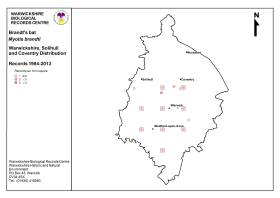
Distribution map for Brandt's bats in Warwickshire. (Click for a full sized image)
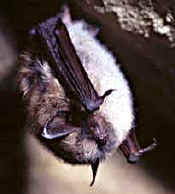 Brandt's
bats (Myotis brandtii) are very similar to Whiskered bats (Myotis
mystacinus) as both are small species with somewhat shaggy fur; the
Whiskered bat being slightly smaller than the Brandt's.
Brandt's
bats (Myotis brandtii) are very similar to Whiskered bats (Myotis
mystacinus) as both are small species with somewhat shaggy fur; the
Whiskered bat being slightly smaller than the Brandt's.
Differences lie in the shape of the inner lobe of the ear (the
tragus), penis and features of the teeth (the shape of the 3rd upper pre-molar).
Brandt's has a large cusp at the base on the inside of this tooth. The
cusp is bigger than the tiny tooth next to it. Whiskered bats have a small
cusp or no cusp.
In the paper "Identification of Whiskered and Brandt's bats"
by Lene Berge from the 'Bat Ecology and Bioacoustics Laboratory', University
of Bristol (presented at the National Bat Conference, University of Reading,
September 2006) pdf
15Kb, Lene Berge says:
"I suggest that the best way of distinguishing between the two
species is by using a
combination of upper jaw dentition, penis shape, tragus shape, thumb claw
length and lower
jaw dentition. Identification should then be based upon how many features
correspond with
each species. However, until a feature with no overlap between species
has been detected or
identification can be verified using molecular methods, all identification
of whiskered and
Brandt’s bats should be regarded with some caution. On the other hand,
it is still important to
keep in mind that the five features mentioned above, used in combination,
did classify 100%
of the bats correctly and that each of these features when used separately
could classify over
80% of the bats to the correct species".
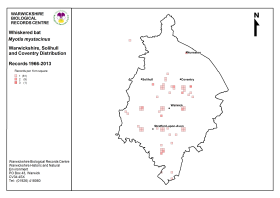
Distribution map for Whiskered bats in Warwickshire. (Click for a full sized image)
Whiskered
and Brandt's bats were only separated as distinct species in 1970. Thus
much of the information previously applied to Whiskered bats might relate
to either species and the difficulties in telling them apart, even in
the hand, makes the identification of differences in their behaviour and
ecology also difficult.
Whiskered and Brandt's bats are found throughout England and Wales and
Whiskered to southern Scotland. It is possible that Brandt's is actually
more common and widespread than Whiskered in parts of Great Britain. Whiskered
is also found throughout Ireland.
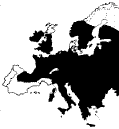 Both
are found through most of Europe, occurring as far north as Scandinavia
but absent from the south and west of the Iberian peninsula. DNA work
in Germany has shown that there is a second, as yet unnamed, species of
Whiskered bat there.
Both
are found through most of Europe, occurring as far north as Scandinavia
but absent from the south and west of the Iberian peninsula. DNA work
in Germany has shown that there is a second, as yet unnamed, species of
Whiskered bat there.
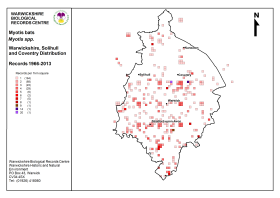
Distribution map for all species of Myotis bats in Warwickshire. (Click for a full sized image)
Whiskered and Brandt's bats are vulnerable to the effects of modern
agricultural practices and decline of woodland, which result in the loss
of suitable feeding habitats and hollow trees for roosting. They are susceptible
to pesticides, especially those used as remedial timber treatment chemicals.
Disturbance and vandalism of their hibernating sites, caves and tunnels,
is an additional threat.
flight & ultrasound
Both species emerge within half an hour of sunset and probably remain
active throughout the night. Whiskered bats have a fast and fluttering
flight, to a height of 20m, generally level with occasional stoops. They
glide briefly, especially when feeding in the canopy. They frequently
fly along a regular path over or alongside a hedgerow or woodland edge.
Brandt's bats have a rapid and skilful flight, flying at a medium height
and more often within woodland. Prey is occasionally picked off foliage.

Whiskered/Brandt's bats have an echolocation range of 35 - 80 kHz with
a peak intensity at 60 kHz. Their calls are quieter than Daubenton's
bat. On a heterodyne bat detector a regular
series of clicks throughout the frequency range can be heard but the sound
can sometimes be distorted when the bats are turning. May easily be overlooked
as a Pipistrelle except for the higher frequency
of peak intensity.
 Brandt's call on a Heterodyne bat detector.
Brandt's call on a Heterodyne bat detector.
 Whiskered call on a Heterodyne bat detector.
Whiskered call on a Heterodyne bat detector.
 Whiskered call on a Time Expansion bat detector.
Whiskered call on a Time Expansion bat detector.
breeding
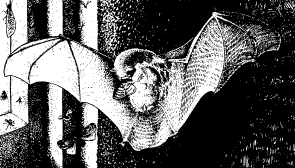 Mating
usually takes place in autumn but has been observed in all winter months.
Adult females segregate from males in the summer to form maternity colonies.
Summer roosts are occupied from April/May until July/August, sometimes
until October with occasional winter records.
Mating
usually takes place in autumn but has been observed in all winter months.
Adult females segregate from males in the summer to form maternity colonies.
Summer roosts are occupied from April/May until July/August, sometimes
until October with occasional winter records.
Females give birth to their single young in June or early July. The baby
is fed solely on its mother's milk. By 3 weeks it is able to fly and by
6 weeks can forage for itself. Some females reach sexual maturity at 3
months (in their first autumn) but the majority do not mate until their
second autumn.
summer roosts
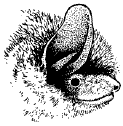 Both
species are regularly found in buildings, though colonies are more commonly
found in the north and west. They are found in all types of houses including
some modern ones but particularly in older buildings with stone walls
and slate roofs.
Both
species are regularly found in buildings, though colonies are more commonly
found in the north and west. They are found in all types of houses including
some modern ones but particularly in older buildings with stone walls
and slate roofs.
Both species are mainly crevice dwellers. Roosts can be under hanging
tiles, above soffits, in cavity walls, above roof under-boarding or along
the tunnel under ridge tiles. They can also sometimes roost in exposed
positions in the roof space under the ridge beams.
Droppings frequently accumulate in the roof below the ridge and especially
below the favoured roost sites but not particularly at gable ends or on
chimneys. Colonies of Whiskered and Brandt's bats may use separate parts
of the same roof as Whiskered, Pipistrelle
or Long-eared bats.
winter roosts
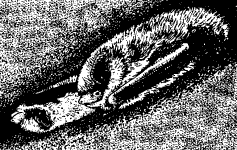 Brandt's
bats are regularly found hibernating in caves and tunnels, but almost
always in small numbers with only a few sites recording more than 20 individuals.
Thus, in Britain, they seem to have a limited reliance on underground
sites and the hibernation sites for most of the population remain unknown.
Some of the regular sites in south-east England are barely underground;
such as the exposed relict entrances to disused lime kilns.
Brandt's
bats are regularly found hibernating in caves and tunnels, but almost
always in small numbers with only a few sites recording more than 20 individuals.
Thus, in Britain, they seem to have a limited reliance on underground
sites and the hibernation sites for most of the population remain unknown.
Some of the regular sites in south-east England are barely underground;
such as the exposed relict entrances to disused lime kilns.
Within cave sites, Whiskered bats are usually found in cold areas close
to the entrance, but occasionally roost in the warmer interior. They may
choose more humid situations than Brandt's bats. Whiskered bats more often
hang exposed, whereas Brandt's bats often lodge in tight crevices and
can be found among clusters of other species. Males may stay in the hibernation
sites until well into May.
| Description |
|
| Head and Body Length |
35 - 50 mm |
| Forearm Length |
30 - 39 mm |
| Wingspan |
200 - 250 mm |
| Weight |
5 - 9g |
| Colour |
Fur dark grey or brown, golden tips on back, greyish underneath.
Face and ears dark brown or black Brandt's bat's face and base of
ears often pinkish.
|
|
|
| |
|
| Life Cycle |
|
| Mating Period |
Autumn and winter. |
| Maternity Colonies |
Established late spring.
Young: 1 born end of June to early July, weaned at 6 weeks. |
| Colony Size |
30 - 200 |
| Longevity |
Up to 20 years (Brandt's) and 20 years (Whiskered). |
| UK Status |
Vulnerable. |
|
|
| |
|
| Habitat and Food |
|
| Summer Roosts |
Mainly buildings, trees. |
| Winter Roosts |
Sometimes caves and tunnels. |
| Feeding Habitat |
Wooded country, often near water. |
| Food |
Moths, other small insects and spiders.

|
further reading
"Flight and echolocation behaviour of whiskered bats commuting along
a hedgerow: range-dependent sonar signal design, Doppler tolerance and
evidence for 'acoustic focussing' " (2006) details